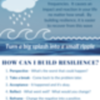My “turn big waves into small ripples” campaign focuses on creating a supportive high school culture with norms and social constructs that encourage students to cope with stressors and positively expressing their emotions. By encouraging a trauma-informed community within the school setting, students will be better prepared to cope with traumas and stressors post-graduation. They will also be capable of passing on this information to their parents, siblings, peers, and future generations.
The campaign materials are comprised of three materials, which target high school students both directly and indirectly (through teachers and administrators). The campaign is built around the symbolism of trauma as a water droplet, with the resulting impact of the trauma(s) on one’s life making “waves” which affect other areas of their lives. Hence, the idea is to “turn big waves into small ripples” by using resiliency to reduce the negative impacts of trauma.
- The infographic is designed to communicate directly to high school students through social media. This format could be posted to Twitter, Facebook, and Pinterest, along with being shared on any school-sanctioned websites or message boards. The infographic is divided into two main sections. The first focuses on the campaign theme and visual. It provides a basic explanation for how trauma can be in many different forms and that it results in an impact and reaction in one’s life. The second section focuses on how students can build resilience, while also highlighting the fact that resilience is different for everyone and there is no one-size-fits-all cure.
- The poster has been designed as an aid for teachers and administrators at the high school, with the intention of having it be posted in teacher’s lounges and on social media (teacher-specific blogs, Pinterest, etc.). It is meant to show how actions and reactions from the adults in the high school environment can factor into a student’s resiliency (Cleaver, 2015). While the information is built off of the American Academy of Pediatrics 7 C’s model, examples have been added to give real-world situations that are applicable to a high school environment (American Academy of Pediatrics, 2014). The overall design of the poster highlights the campaign theme of mitigating trauma impacts on students.
- The Public Service Announcement is an approximately one-minute video that communicates the theme of the campaign in an easily-digestible format for students. This could be shown during school announcements, as well as being posted on YouTube, Twitter, and Facebook. The PSA follows the same layout of the infographic, with the first section being devoted to explaining the concept of trauma and resiliency through the theme, and the second section providing examples of resilience-building strategies.
This campaign focuses on the community level of the social-ecological model, with a particular focus on the high school community. By focusing on this level, this campaign can work to change the cultural values and norms surrounding mental health, trauma, and resilience in students before they graduate and enter adulthood (Center for Disease Control and Prevention, 2019). Students can change their thoughts and beliefs about trauma and resilience at a relatively early point in their lives.
During high school, teachers will be encouraged to consider trauma-informed strategies and support resilience building. School officials will be encouraged to have open and honest conversations with the students in an effort to learn about their students’ needs and help them develop and implement their trauma-informed strategies (Lippman & Schmitz, 2013). Fellow students will have the ability to discuss their knowledge and understanding of resilience with each other, as well as practice these strategies in real-life situations that may arise. By encouraging such a campaign at this point in an individual’s life, they will be able to use resiliency in their future endeavors and mitigate the impact of trauma throughout their life.
References
American Academy of Pediatrics. (2014). Reaching Teens: Strength-Based Communication Strategies to Build Resilience and Support Healthy Adolescent Development. Retrieved from https://www.aap.org/en-us/prof...ding_7Cs_handout.pdf
Center for Disease Control and Prevention. (2019). The social-ecological model: A framework for prevention. Retrieved from https://www.cdc.gov/violencepr...ecologicalmodel.html
Cleaver, S. (2015). 8 ways to help your students build resiliency. We Are Teachers. Retrieved from https://www.weareteachers.com/...ts-build-resiliency/
Lippman, L., & Schmitz, H. (2013). What can schools do to build resilience in their children? Child Trends. Retrieved fromhttps://www.childtrends.org/wh...ce-in-their-students


Comments (1)